Syria
Syrian Arab Republic ٱلْجُمْهُورِيَّةُ ٱلْعَرَبِيَّة ٱلْسُوْرِيَّة ( Arabic )al-Jumhūriyya al-ʿArabiyya as-Sūriya | ||
|---|---|---|
| Motto: وَحْدَةٌ ، حُرِّيَّةٌ ، اِشْتِرَاكِيَّةٌ Waḥda, Ḥurriyya, Ishtirākiyya "Unity, Freedom, Socialism" | ||
| Anthem: حُمَاةَ الدِّيَارِ Ḥumāt ad-Diyār " | ||
| Religion (2023)[2] | ||
Syrian | ||
| Government | Unitary presidential republic[4] under a totalitarian[5] hereditary dictatorship | |
| Bashar al-Assad | ||
| Najah al-Attar | ||
| Hussein Arnous | ||
| Hammouda Sabbagh | ||
| Legislature | independence | 17 April 1946 |
• Left the United Arab Republic | 28 September 1961 | |
| 8 March 1963 | ||
| 27 February 2012 | ||
سوريا. | ||
Syria,
The name "Syria" historically referred to a
The post-independence period was tumultuous, with multiple
After the death of Hafiz al-Assad in 2000, his son Bashar al-Assad inherited the presidency and political system centered around a cult of personality to the al-Assad family. The Ba'ath regime is a totalitarian dictatorship that has been internationally condemned for its political repression alongside its numerous human rights abuses, including summary executions, massive censorship, forced disappearances, mass-murders, barrel-bombings, chemical attacks and other war-crimes. Following its violent suppression of the Arab Spring protests of the 2011 Syrian Revolution, the Syrian government was suspended from the Arab League in November 2011 for over 11 years, until its reinstatement in 2023. Since July 2011, Syria has been embroiled in a multi-sided civil war, with involvement of different countries. The Organisation of Islamic Cooperation suspended Syria in August 2012 citing "deep concern at the massacres and inhuman acts" perpetrated by forces loyal to Bashar al-Assad.[c] As of 2020, three political entities – the Syrian Interim Government, Syrian Salvation Government, and Autonomous Administration of North and East Syria – have emerged in Syrian territory to challenge Assad's rule.
Syria is a member of the
Etymology
Several sources indicate that the name Syria is derived from the 8th century BC
The area designated by the word has changed over time. Classically, Syria lies at the eastern end of the Mediterranean, between
By Pliny's time, however, this larger Syria had been divided into a number of provinces under the
History
Ancient antiquity

Since approximately 10,000 BC, Syria was one of the centers of
The earliest recorded indigenous civilization in the region was the Kingdom of
.
One of the earliest written texts from Syria is a trading agreement between Vizier
Ebla was weakened by a long war with Mari, and the whole of Syria became part of the Mesopotamian Akkadian Empire after Sargon of Akkad and his grandson Naram-Sin's conquests ended Eblan domination over Syria in the first half of the 23rd century BC.[48][49]
By the 21st century BC,
From this time, Syria became a battle ground for various foreign empires, these being the
Around the 14th century BC, various Semitic peoples appeared in the area, such as the semi-nomadic Suteans who came into an unsuccessful conflict with Babylonia to the east, and the West Semitic speaking Arameans who subsumed the earlier Amorites. They too were subjugated by Assyria and the Hittites for centuries. The Egyptians fought the Hittites for control over western Syria; the fighting reached its zenith in 1274 BC with the Battle of Kadesh.[60][61] The west remained part of the Hittite empire until its destruction c. 1200 BC,[62] while eastern Syria largely became part of the Middle Assyrian Empire,[63] who also annexed much of the west during the reign of Tiglath-Pileser I 1114–1076 BC.
With the destruction of the Hittites and the decline of Assyria in the late 11th century BC, the Aramean tribes gained control of much of the interior, founding states such as

A
Syria and the Western half of
The Assyrian Empire was followed by the Neo-Babylonian Empire (605 BC – 539 BC). During this period, Syria became a battle ground between Babylonia and another former Assyrian colony, that of Egypt. The Babylonians, like their Assyrian relations, were victorious over Egypt.
Classical antiquity

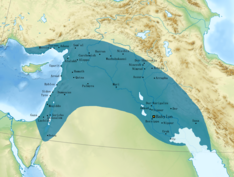

Lands that constitute modern day Syria were part of the
Syria was later conquered by the
Thus, it was the Greeks who introduced the name "Syria" to the region. Originally an Indo-European corruption of "Assyria" in northern Mesopotamia (Iraq), the Greeks used this term to describe not only Assyria itself but also the lands to the west which had for centuries been under Assyrian dominion.
Syria briefly came under
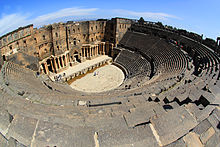
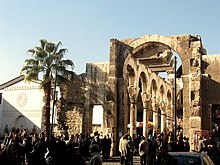
Palmyra, a rich and sometimes powerful native Aramaic-speaking kingdom arose in northern Syria in the 2nd century; the Palmyrene established a trade network that made the city one of the richest in the Roman empire. Eventually, in the late 3rd century AD, the Palmyrene king Odaenathus defeated the Persian emperor Shapur I and controlled the entirety of the Roman East while his successor and widow Zenobia established the Palmyrene Empire, which briefly conquered Egypt, Syria, Palestine, much of Asia Minor, Judah and Lebanon, before being finally brought under Roman control in 273 AD.
The northern Mesopotamian
The Aramaic language has been found as far afield as Hadrian's Wall in Ancient Britain,[66] with an inscription written by a Palmyrene emigrant at the site of Fort Arbeia.[67]
Control of Syria eventually passed from the Romans to the Byzantines, with the split in the Roman Empire.[44]
The largely

Syrians held considerable amounts of power during the
Syria is significant in the
Middle Ages
By AD 640, Syria
Sections of Syria were held by French, English,
A few months later, the Mamluks arrived with an army from Egypt and defeated the Mongols in the
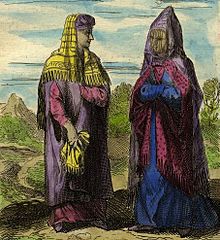
Ottoman Syria
In 1516, the Ottoman Empire invaded the Mamluk Sultanate of Egypt, conquering Syria, and incorporating it into its empire. The Ottoman system was not burdensome to Syrians because the Turks respected Arabic as the language of the Quran, and accepted the mantle of defenders of the faith. Damascus was made the major entrepot for Mecca, and as such it acquired a holy character to Muslims, because of the beneficial results of the countless pilgrims who passed through on the hajj, the pilgrimage to Mecca.[79]
Ottoman administration followed a system that led to peaceful coexistence. Each

During
French Mandate

In 1920, a short-lived independent
In 1925, Sultan al-Atrash led a revolt that broke out in the Druze Mountain and spread to engulf the whole of Syria and parts of Lebanon. Al-Atrash won several battles against the French, notably the Battle of al-Kafr on 21 July 1925, the Battle of al-Mazraa on 2–3 August 1925, and the battles of Salkhad, al-Musayfirah and Suwayda. France sent thousands of troops from Morocco and Senegal, leading the French to regain many cities, although resistance lasted until the spring of 1927. The French sentenced Sultan al-Atrash to death, but he had escaped with the rebels to Transjordan and was eventually pardoned. He returned to Syria in 1937 after the signing of the Syrian-French Treaty.
Syria and France negotiated a
Independent Syrian Republic
Upheaval dominated Syrian politics from independence through the late 1960s. In May 1948, Syrian forces invaded
Shishakli eventually abolished multipartyism altogether, but was himself overthrown in a
In November 1956, as a direct result of the Suez Crisis,[91] Syria signed a pact with the Soviet Union. This gave a foothold for Communist influence within the government in exchange for military equipment.[89] Turkey then became worried about this increase in the strength of Syrian military technology, as it seemed feasible that Syria might attempt to retake İskenderun. Only heated debates in the United Nations lessened the threat of war.[92]
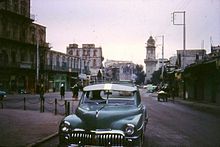
On 1 February 1958, Syrian President Shukri al-Quwatli and Egypt's Nasser announced the merging of Egypt and Syria, creating the United Arab Republic, and all Syrian political parties, as well as the communists therein, ceased overt activities.[85] Meanwhile, a group of Syrian Ba'athist officers, alarmed by the party's poor position and the increasing fragility of the union, decided to form a secret Military Committee; its initial members were Lieutenant-Colonel Muhammad Umran, Major Salah Jadid and Captain Hafiz al-Assad. Syria seceded from the union with Egypt on 28 September 1961, after a coup.
Ba'athist Syria
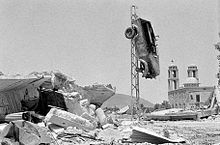
The ensuing instability following the
On 23 February 1966, the
In the first half of 1967, a low-key state of war existed between Syria and Israel. Conflict over Israeli cultivation of land in the Demilitarized Zone led to 7 April pre-war aerial clashes between Israel and Syria.[97] When the Six-Day War broke out between Egypt and Israel, Syria joined the war and attacked Israel as well. In the final days of the war, Israel turned its attention to Syria, capturing two-thirds of the Golan Heights in under 48 hours.[98] The defeat caused a split between Jadid and Assad over what steps to take next.[99]
Ba'athist Syria under Assad
Disagreement developed between Jadid, who controlled the party apparatus, and Assad, who controlled the military. The 1970 retreat of Syrian forces sent to aid the

The power struggle culminated in the November
On 6 October 1973, Syria and Egypt initiated the

In a major shift in relations with both other
Hafiz al-Assad died on 10 June 2000. His son,
On 5 October 2003, Israel
Current political situation 2011 to present
Syrian Civil War
The ongoing
According to various sources, including the United Nations, up to 100,000 people had been killed by June 2013,[119][120][121] including 11,000 children.[122] To escape the violence, 4.9 million[123] Syrian refugees have fled to neighboring countries of Jordan,[124] Iraq,[125] Lebanon, and Turkey.[126][127] An estimated 450,000 Syrian Christians have fled their homes.[128][needs update] By October 2017, an estimated 400,000 people had been killed in the war according to the UN.[129]
In September 2022, a new UN report stated that the Syrian Civil War was in danger of flaring up again. The UN also said it had been totally unable to deliver any supplies during the first half of 2022.[130]
Current conflicts
(For a more detailed, interactive map, see Template:Syrian Civil War detailed map
As of 2022, the main external military threat and conflict are firstly, an ongoing conflict with ISIS; and secondly, ongoing concerns of possible invasion of the northeast regions of Syria by Turkish forces, in order to strike Kurdish groups in general, and
As of 2023, Turkey was continuing its support for various militias within Syria, which periodically attempted some operations against Kurdish groups consisting mostly of the YPG/YPJ.
In 2022, the leader of the Syrian Democratic Forces (SDF), Mazloum Abdi, said that Kurdish forces were willing to work with Syrian government forces to defend against Turkey, saying “Damascus should use its air defense systems against Turkish planes." Abdi said that Kurdish groups would be able to cooperate with the Syrian government, and still retain their autonomy.[140][141][142][143][144] In July 2022, the SDF and the official Syrian military forged active plans to coordinate actively together to create defense plans to guard against invasion by Turkey.[145] The SDF said that they felt that the main threat to Kurdish groups was an invasion by Turkey.[146]
As of 2023, active fighting in the conflict between the Syrian government and rebel groups had mostly subsided, but there were occasional flareups in Northwestern Syria.[147][148] In early 2023, reports indicated that the forces of ISIS in Syria had mostly been defeated, with only a few cells remaining in various remote locations.[149][150][151]
Major economic crisis
On 10 June 2020, hundreds of protesters returned to the streets of Sweida for the fourth consecutive day, rallying against the collapse of the country's economy, as the Syrian pound plummeted to 3,000 to the dollar within the previous week.[152]
On 11 June, Prime Minister Imad Khamis was dismissed by President Bashar al-Assad, amid anti-government protests over deteriorating economic conditions.[153] The new lows for the Syrian currency, and the dramatic increase in sanctions, began to appear to raise new concerns about the survival of the Assad government.[154][155][156] Analysts noted that a resolution to the current banking crisis in Lebanon might be crucial to restoring stability in Syria.[157]
Some analysts began to raise concerns that Assad might be on the verge of losing power; but that any such collapse in the regime might cause conditions to worsen, as the result might be mass chaos, rather than an improvement in political or economic conditions.
The first new sanctions took effect on 17 June. There will be additional sanctions implemented in August, in three different groups. There are increasing reports that food is becoming difficult to find, the country's economy is under severe pressure, and the whole regime could collapse due to the sanctions.[163] As of early 2022, Syria was still facing a major economic crisis due to sanctions and other economic pressures. there was some doubt of the Syrian government's ability to pay for subsisides for the population and for basic services and programs.[164][165][166] The UN reported there were massive problems looming for Syria's ability to feed its population in the near future.[167]
In one possibly positive sign for the well-being of Syria's population, several Arab countries began an effort to normalize relations with Syria, and to conclude a deal to provide energy supplies to Syria. This effort was led by Jordan, and included several other Arab countries.[168]
Geography
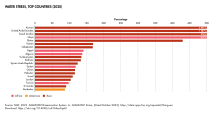
Syria lies between latitudes
Petroleum in commercial quantities was first discovered in the northeast in 1956. The most important oil fields are those of al-Suwaydiyah, Karatchok, Rmelan near al-Hasakah, as well as al-Omar and al-Taym fields near Dayr az–Zawr. The fields are a natural extension of the Iraqi fields of Mosul and Kirkuk. Petroleum became Syria's leading natural resource and chief export after 1974. Natural gas was discovered at the field of Jbessa in 1940.[85]
Biodiversity
Syria contains four terrestrial ecoregions:
Politics and government

|

|
| Bashar al-Assad |
Hussein Arnous |
Syria is a
The
The
Syria's
There is no independent judiciary in Syria, since all judges and prosecutors are required to be Ba'athist appointees.
Military
The President of Syria is commander in chief of the Syrian armed forces, comprising some 400,000 troops upon mobilization. The military is a conscripted force; males serve in the military upon reaching the age of 18.[citation needed] The obligatory military service period is being decreased over time, in 2005 from two and a half years to two years, in 2008 to 21 months and in 2011 to year and a half.[210] About 20,000 Syrian soldiers were deployed in Lebanon until 27 April 2005, when the last of Syria's troops left the country after three decades.[citation needed]
The breakup of the Soviet Union—long the principal source of training, material, and credit for the Syrian forces—may have slowed Syria's ability to acquire modern military equipment. It has an arsenal of surface-to-surface missiles. In the early 1990s,
Syria received significant financial aid from
Foreign relations
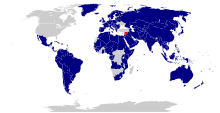
Ensuring national security, increasing influence among its
Since the ongoing civil war of 2011, and associated killings and human rights abuses, Syria has been increasingly isolated from the countries in the region, and the wider international community. Diplomatic relations have been severed with several countries including: Britain, Canada, France, Italy, Germany, Tunisia, Egypt, Libya, the United States, Belgium, Spain, and the Arab states of the Persian Gulf.[212]

From the Arab league, Syria continues to maintain diplomatic relations with Algeria, Egypt, Iraq, Lebanon, Sudan and Yemen. Syria's violence against civilians has also seen it suspended from the Arab League and the Organisation of Islamic Cooperation in 2012.[213] Syria also quit the Union for the Mediterranean.[214] After 11 years, the Arab League readmitted Syria.[215] Syria continues to foster good relations with its traditional allies, Iran and Russia, who are among the few countries which have supported the Syrian government in its conflict with the Syrian opposition.
Syria is included in the European Union's European Neighbourhood Policy (ENP) which aims at bringing the EU and its neighbors closer.
International disputes
In 1939, while Syria was still a French mandate the French allowed a plebiscite regarding the Sanjak of Alexandretta joining to Turkey as part of a treaty of friendship in World War II. In order to facilitate this, a faulty election was done in which ethnic Turks who were originally from the Sanjak but lived in Adana and other areas near the border in Turkey came to vote in the elections, shifting the election in favor of secession. Through this, the Hatay Province of Turkey was formed. The move by the French was very controversial in Syria, and only five years later Syria became independent.[216] Despite the Turkish annexation of the Sanjak of Alexandretta, the Syrian government has refused to recognize Turkish sovereignty over the region since Independence, except for a short period during the year of 1949.[217]
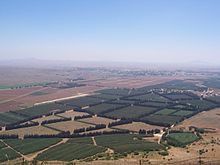
The western two-thirds of Syria's Golan Heights region are since 1967 occupied by Israel and were in 1981 effectively annexed by Israel,[218][219] whereas the eastern third is controlled by Syria, with the UNDOF maintaining a buffer zone in between, to implement the ceasefire of the Purple Line. Israel's 1981 Golan annexation law is not recognized in international law. The UN Security Council condemned it in Resolution 497 (1981) as "null and void and without international legal effect." Since then, General Assembly resolutions on "The Occupied Syrian Golan" reaffirm the illegality of Israeli occupation and annexation.[220] The Syrian government continues to demand the return of this territory.[221] The only remaining land Syria has in the Golan is a strip of territory which contains the abandoned city of Quneitra, the governorate's de facto capital Madinat al-Baath and many small villages, mostly populated by Circassians such as Beer Ajam and Hader.[dubious ] In March 2019, U.S. President Donald Trump announced that the United States will recognize Israel's annexation of the Golan Heights.[222]
In early 1976, Syria entered Lebanon, beginning their twenty-nine-year military presence. Syria entered on the invitation of Suleiman Franjieh, the Maronite Christian president at the time to help aid the Lebanese Christian militias against the Palestinian militias.
Another disputed territory is the
Human rights

The situation for human rights in Syria has long been a significant concern among independent organizations such as Human Rights Watch, who in 2010 referred to the country's record as "among the worst in the world."[229] The 2011 Freedom House report[230] ranked Syria "Not Free" in its annual Freedom in the World survey.[231]
The authorities are accused of arresting democracy and human rights activists,
In August 2013, the government was suspected of using chemical weapons against its civilians. US Secretary of State John Kerry said it was "undeniable" that chemical weapons had been used in the country and that President Bashar al-Assad's forces had committed a "moral obscenity" against his own people. "Make no mistake," Kerry said. "President Obama believes there must be accountability for those who would use the world's most heinous weapon against the world's most vulnerable people. Nothing today is more serious, and nothing is receiving more serious scrutiny".[238] The Emergency Law, effectively suspending most constitutional protections, was in effect from 1963 until 21 April 2011.[192] It was justified by the government in the light of the continuing war with Israel over the Golan Heights.
In August 2014,
Administrative divisions
Syria is divided into 14
| No. | Governorate | Capital | |
|---|---|---|---|
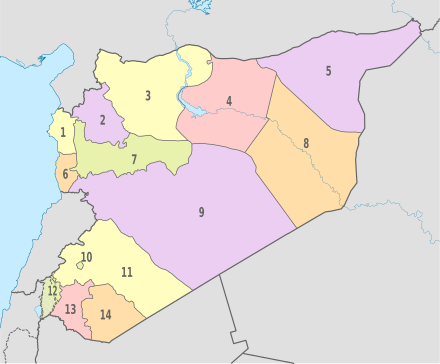 | |||
| 1 | Latakia | Latakia | |
| 2 | Idlib | Idlib | |
| 3 | Aleppo | Aleppo | |
| 4 | Raqqa | Raqqa | |
| 5 | Al-Hasakah | Al-Hasakah | |
| 6 | Tartus | Tartus | |
| 7 | Hama | Hama | |
| 8 | Deir ez-Zor | Deir ez-Zor | |
| 9 | Homs | Homs | |
| 10 | Damascus | Damascus | |
| 11 | Rif Dimashq | Douma | |
| 12 | Quneitra | Quneitra | |
| 13 | Daraa | Daraa | |
| 14 | Al-Suwayda | Al-Suwayda
|
Autonomous Administration of North and East Syria
The
While entertaining
The supporters of the region's administration state that it is an officially
On 13 October 2019, the SDF announced that it had reached an agreement with the Syrian Army which allowed the latter to enter the SDF-held cities of Manbij and Kobani in order to dissuade a Turkish attack on those cities as part of the cross-border offensive by Turkish and Turkish-backed Syrian rebels.[281] The Syrian Army also deployed in the north of Syria together with the SDF along the Syrian-Turkish border and entered into several SDF-held cities such as Ayn Issa and Tell Tamer.[282][283] Following the creation of the Second Northern Syria Buffer Zone the SDF stated that it was ready to work cooperatively with the Syrian Army if a political settlement between the Syrian government and the SDF was achieved.[284]
Largest cities
Largest cities or towns in Syria
Syria Central Bureau of Statistics (2004 Census) | |||||||||
|---|---|---|---|---|---|---|---|---|---|
| Rank | Name | Province
|
Pop. | Rank | Name | Province
|
Pop. | ||
 Aleppo  Damascus |
1 | Aleppo | Aleppo Governorate | 2,132,100 | 11 | Tartus | Tartus Governorate | 115,769 |  Homs  Latakia |
| 2 | Damascus | Damascus | 1,552,161 | 12 | Jaramana | Rif Dimashq Governorate | 114,363 | ||
| 3 | Homs | Homs Governorate | 652,609 | 13 | Douma, Syria | Rif Dimashq Governorate | 110,893 | ||
| 4 | Latakia | Latakia Governorate | 383,786 | 14 | Manbij | Aleppo Governorate | 99,497 | ||
| 5 | Hama | Hama Governorate | 312,994 | 15 | Idlib | Idlib Governorate | 98,791 | ||
| 6 | Raqqa | Raqqa Governorate | 220,488 | 16 | Daraa | Daraa Governorate | 97,969 | ||
| 7 | Deir ez-Zor | Deir ez-Zor Governorate | 211,857 | 17 | Al-Hajar al-Aswad | Rif Dimashq Governorate | 84,948 | ||
| 8 | Hasakah |
Al-Hasakah Governorate | 188,160 | 18 | Darayya | Rif Dimashq Governorate | 78,763 | ||
| 9 | Qamishli | Al-Hasakah Governorate | 184,231 | 19 | Suwayda |
As-Suwayda Governorate | 73,641 | ||
| 10 | Sayyidah Zaynab | Rif Dimashq Governorate | 136,427 | 20 | Al-Thawrah | Raqqa Governorate | 69,425 | ||
Agrarian reform
Agrarian reform measures were introduced into Syria which consisted of three interrelated programs: Legislation regulation the relationship between agriculture laborers and landowners: legislation governing the ownership and use of private and state domain land and directing the economic organization of peasants; and measures reorganizing agricultural production under state control.[285] Despite high levels of inequality in land ownership these reforms allowed for progress in redistribution of land from 1958 to 1961 than any other reforms in Syria's history, since independence.
The first law passed (Law 134; passed 4 September 1958) in response to concern about peasant mobilization and expanding peasants' rights.[286] This was designed to strengthen the position of sharecroppers and agricultural laborers in relation to land owners.[286] This law led to the creation of the Ministry of Labor and Social Affairs, which announced the implementation of new laws that would allow the regulation of working condition especially for women and adolescents, set hours of work, and introduce the principle of minimum wage for paid laborers and an equitable division of harvest for sharecroppers.[287] Furthermore, it obligated landlords to honor both written and oral contracts, established collective bargaining, contained provisions for workers' compensation, health, housing, and employment services.[286] Law 134 was not designed strictly to protect workers. It also acknowledged the rights of landlords to form their own syndicates.[286]
Internet and telecommunications
Economy

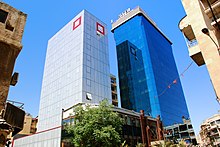
As of 2015[update], the Syrian economy relies upon inherently unreliable revenue sources such as dwindling customs and income taxes which are heavily bolstered by lines of credit from Iran.
Syria's share in global exports has eroded gradually since 2001.
Political instability poses a significant threat to future economic development.[300] Foreign investment is constrained by violence, government restrictions, economic sanctions, and international isolation. Syria's economy also remains hobbled by state bureaucracy, falling oil production, rising budget deficits, and inflation.[300] Prior to the civil war in 2011, the government hoped to attract new investment in the tourism, natural gas, and service sectors to diversify its economy and reduce its dependence on oil and agriculture. The government began to institute economic reforms aimed at liberalizing most markets, but those reforms were slow and ad hoc, and have been completely reversed since the outbreak of conflict in 2011.[301]

As of 2012[update], because of the ongoing Syrian civil war, the value of Syria's overall exports has been slashed by two-thirds, from the figure of US$12 billion in 2010 to only US$4 billion in 2012.[302] Syria's GDP declined by over 3% in 2011,[303] and is expected to further decline by 20% in 2012.[304] As of 2012[update], Syria's oil and tourism industries in particular have been devastated, with US$5 billion lost to the ongoing conflict of the civil war.[302] Reconstruction needed because of the ongoing civil war will cost as much as US$10 billion.[302] Sanctions have sapped the government's finances. US and European Union bans on oil imports, which went into effect in 2012, are estimated to cost Syria about $400 million a month.[305] Revenues from tourism have dropped dramatically, with hotel occupancy rates falling from 90% before the war to less than 15% in May 2012.[306] Around 40% of all employees in the tourism sector have lost their jobs since the beginning of the war.[306]
In May 2015,
Drug industry
Syria is home to a burgeoning
Petroleum industry

Syria's petroleum industry has been subject to a sharp decline. In September 2014, ISIS was producing more oil than the government at 80,000 bbl/d (13,000 m3/d) compared to the government's 17,000 bbl/d (2,700 m3/d) with the Syrian Oil Ministry stating that by the end of 2014, oil production had plunged further to 9,329 bbl/d (1,483.2 m3/d); ISIS has since captured a further oil field, leading to a projected oil production of 6,829 bbl/d (1,085.7 m3/d).[292] In the third year of the Syrian Civil War, the deputy economy minister Salman Hayan stated that Syria's two main oil refineries were operating at less than 10% capacity.[314]
Historically, the country produced heavy-grade oil from fields located in the northeast since the late 1960s. In the early 1980s, light-grade, low-sulphur oil was discovered near Deir ez-Zor in eastern Syria. Syria's rate of oil production has decreased dramatically from a peak close to 600,000 barrels per day (95,000 m3/d) (bpd) in 1995 down to less than 182,500 bbl/d (29,020 m3/d) in 2012.[315] Since 2012 the production has decreased even more, reaching 32,000 barrels per day (5,100 m3/d) (bpd) in 2014. Official figures quantity the production in 2015 at 27,000 barrels per day (4,300 m3/d), but those figures have to be taken with precaution because it is difficult to estimate the oil that is currently produced in the rebel held areas.
Prior to the uprising, more than 90% of Syrian oil exports were to EU countries, with the remainder going to Turkey.[306] Oil and gas revenues constituted in 2012 around 20% of total GDP and 25% of total government revenue.[306]
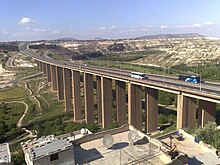
Transport
Syria has four international airports (Damascus, Aleppo, Lattakia and Kamishly), which serve as hubs for Syrian Air and are also served by a variety of foreign carriers.[316]
The majority of Syrian cargo is carried by Syrian Railways (the Syrian railway company), which links up with Turkish State Railways (the Turkish counterpart). For a relatively underdeveloped country, Syria's railway infrastructure is well maintained with many express services and modern trains.[317]
The road network in Syria is 69,873 kilometres (43,417 miles) long, including 1,103 kilometres (685 miles) of expressways. The country also has 900 kilometres (560 miles) of navigable but not economically significant waterways.[8]
Water supply and sanitation
Syria is a semiarid country with scarce water resources. The largest water consuming sector in Syria is agriculture. Domestic water use stands at only about 9% of total water use.[318] A big challenge for Syria before the civil war was its high population growth (in 2006 the growth rate was 2.7%[319]), leading to rapidly increasing demand for urban and industrial water.[320]
Demographics
| Year | Pop. | ±% p.a. |
|---|---|---|
| 1960 | 4,565,000 | — |
| 1970 | 6,305,000 | +3.28% |
| 1981 | 9,046,000 | +3.34% |
| 1994 | 13,782,000 | +3.29% |
| 2004 | 17,921,000 | +2.66% |
| 2011 | 21,124,000 | +2.38% |
| 2015 | 18,734,987 | −2.96% |
| 2019 | 18,528,105 | −0.28% |
| 2019 estimate[321] Source: Central Bureau of Statistics of the Syrian Arab Republic, 2011[322] | ||
Most people live in the
In what the UN has described as "the biggest humanitarian emergency of our era",
Ethnic groups

Syrians are an overall indigenous
The second-largest ethnic group in Syria are the
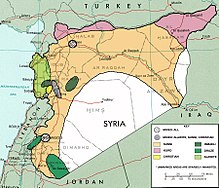
There are also smaller ethnic minority groups, such as the
Religion
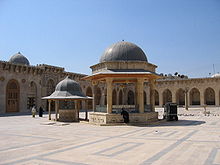
President Bashar al-Assad's family is Alawite and Alawites dominate the government of Syria and hold key military positions.
Syria was once home to a substantial population of Jews, with large communities in Damascus, Aleppo, and Qamishii. Due to a combination of persecution in Syria and opportunities elsewhere, the Jews began to emigrate in the second half of the 19th century to Great Britain, the United States, and Israel. The process was completed with the establishment of the State of Israel in 1948. In 2021 there were no Jews left in Syria.[348]
Languages
English and French are widely spoken as second languages, but English is more often used.[350]
Education
Education is free and compulsory from ages 6 to 12. Schooling consists of 6 years of primary education followed by a 3-year general or
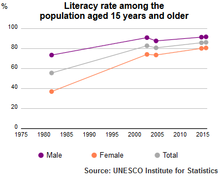
Since 1967, all schools, colleges, and universities have been under close government supervision by the Ba'ath Party.[353]
There are 6 state universities in Syria[354] and 15 private universities.[355] The top two state universities are Damascus University (210,000 students as of 2014)[356] and University of Aleppo.[357] The top private universities in Syria are: Syrian Private University, Arab International University, University of Kalamoon and International University for Science and Technology. There are also many higher institutes in Syria, like the Higher Institute of Business Administration, which offer undergraduate and graduate programs in business.[358]
According to the Webometrics Ranking of World Universities, the top-ranking universities in the country are Damascus University (3540th worldwide), the University of Aleppo (7176th) and Tishreen University (7968th).[359]
Health
In 2010, spending on healthcare accounted for 3.4% of the country's GDP. In 2008, there were 14.9 physicians and 18.5 nurses per 10,000 inhabitants.[360] The life expectancy at birth was 75.7 years in 2010, or 74.2 years for males and 77.3 years for females.[361]
Culture
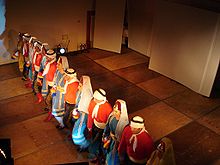
Syria is a traditional society with a long cultural history.
Literature
The literature of Syria has contributed to
Ba'ath Party rule, since the
Music
The Syrian music scene, in particular that of Damascus, has long been among the Arab world's most important, especially in the field of
Media

Nearly all of
Cuisine
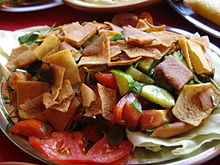
Syrian cuisine is rich and varied in its ingredients, linked to the regions of Syria where a specific dish has originated. Syrian food mostly consists of Southern Mediterranean, Greek, and Southwest Asian dishes. Some Syrian dishes also evolved from Turkish and French cooking: dishes like shish kebab, stuffed zucchini/courgette, and yabraʾ (stuffed grape leaves, the word yabraʾ deriving from the Turkish word yaprak, meaning leaf).
The main dishes that form Syrian cuisine are
Drinks in Syria vary, depending on the time of day and the occasion.
See also
References
Notes
- Arabic: سُورِيَا or سُورِيَة, romanized: Sūriyā
- Arabic: الجمهورية العربية السورية, romanized: al-Jumhūriyya al-ʿArabiyya as-Sūriya
- ^ Sources:
- [11]
- Alsharif, Asma (16 August 2012). "Organization of Islamic Cooperation suspends Syria". Reuters. Archived from the original on 22 September 2022.
- "Islamic bloc suspends Syria membership over crisis". DW News. 16 August 2012. Archived from the original on 27 June 2018.
- "Organisation of Islamic Cooperation suspends Syria". Ahram Online. 16 August 2012. Archived from the original on 1 July 2018.
- "OIC Suspends Syria Over Crackdown". RFE/RL. 16 August 2012. Archived from the original on 8 February 2023.
- ^ Sources:
- * "Corruption Perceptions Index – 2022". Transparency International. 2022. Archived from the original on 4 February 2023.
- "Middle East corruption rankings: Syria most corrupt, UAE least, Turkey slipped". Al-Monitor. 31 January 2023. Archived from the original on 3 February 2023.
- "Corruption in Syria". Worlddata.info. 2022. Archived from the original on 14 November 2022.
- "Syria, Yemen and Libya among 'lowest in the world' for corruption perceptions". The New Arab. 31 January 2023. Archived from the original on 8 February 2023.
- ^ Sources:[16][17][18][19][20][21][22][23]
- ^ [25][26][27][28]
- ^ Sources describing Syria as a totalitarian state:
- Khamis, B. Gold, Vaughn, Sahar, Paul, Katherine (2013). "22. Propaganda in Egypt and Syria's "Cyberwars": Contexts, Actors, Tools, and Tactics". In Auerbach, Castronovo, Jonathan, Russ (ed.). The Oxford Handbook of Propaganda Studies. Madison Avenue, New York, NY: Oxford University Press. p. 422. ISBN 978-0-19-976441-9.)
{{cite book}}: CS1 maint: multiple names: authors list (link
- Khamis, B. Gold, Vaughn, Sahar, Paul, Katherine (2013). "22. Propaganda in Egypt and Syria's "Cyberwars": Contexts, Actors, Tools, and Tactics". In Auerbach, Castronovo, Jonathan, Russ (ed.). The Oxford Handbook of Propaganda Studies. Madison Avenue, New York, NY: Oxford University Press. p. 422.
- Wieland, Carsten (2018). "6: De-neutralizing Aid: All Roads Lead to Damascus". Syria and the Neutrality Trap: The Dilemmas of Delivering Humanitarian Aid Through Violent Regimes. 50 Bedford Square, London, WC1B 3DP, UK: I. B. Tauris. p. 68. ISBN 978-0-7556-4138-3.)
{{cite book}}: CS1 maint: location (link - Meininghaus, Esther (2016). "Introduction". Creating Consent in Ba'thist Syria: Women and Welfare in a Totalitarian State. I. B. Tauris. pp. 1–33. ISBN 978-1-78453-115-7.
- Sadiki, Larbi; Fares, Obaida (2014). "12: The Arab Spring Comes to Syria: Internal Mobilization for Democratic Change, Militarization and Internationalization". Routledge Handbook of the Arab Spring: Rethinking Democratization. Routledge. p. 147. ISBN 978-0-415-52391-2.
- ^ The name "Rojava" ("The West") was initially used by the region's PYD-led government, before its usage was dropped in 2016.[246][247][248] Since then, the name is still used by locals and international observers.
Citations
- ^ a b "Constitution of the Syrian Arab Republic – 2012" (PDF). International Labour Organization. Retrieved 31 August 2020.
- ^ a b c "Syria: People and society". The World Factbook. CIA. 10 May 2022.
- ^ "Largest Ethnic Groups In Syria". WorldAtlas. 7 June 2018. Retrieved 18 August 2022.
- ^
- "Syrian Arab Republic". Federal Foreign Office. 13 January 2023. Archived from the original on 25 March 2023.
System of government: Officially a socialist,... democratic state; presidential system (ruled by the al-Assad family, with the security services occupying a powerful position)
- "Syria: Government". CIA World Factbook. Archived from the original on 3 February 2021.
- "Syria Government". Archived from the original on 27 January 2023.
- "Syrian Arab Republic: Constitution, 2012". refworld. 26 February 2021. Archived from the original on 5 March 2019.
- "Syrian Arab Republic". Federal Foreign Office. 13 January 2023. Archived from the original on 25 March 2023.
- ^
- Khamis, B. Gold, Vaughn, Sahar, Paul, Katherine (2013). "22. Propaganda in Egypt and Syria's "Cyberwars": Contexts, Actors, Tools, and Tactics". In Auerbach, Castronovo, Jonathan, Russ (ed.). The Oxford Handbook of Propaganda Studies. 198 Madison Avenue, New York, NY 10016: Oxford University Press. p. 422. ISBN 978-0-19-976441-9.)
{{cite book}}: CS1 maint: location (link) CS1 maint: multiple names: authors list (link
- Khamis, B. Gold, Vaughn, Sahar, Paul, Katherine (2013). "22. Propaganda in Egypt and Syria's "Cyberwars": Contexts, Actors, Tools, and Tactics". In Auerbach, Castronovo, Jonathan, Russ (ed.). The Oxford Handbook of Propaganda Studies. 198 Madison Avenue, New York, NY 10016: Oxford University Press. p. 422.
- Wieland, Carsten (2018). "6: De-neutralizing Aid: All Roads Lead to Damascus". Syria and the Neutrality Trap: The Dilemmas of Delivering Humanitarian Aid Through Violent Regimes. 50 Bedford Square, London, WC1B 3DP, UK: I. B. Tauris. p. 68. ISBN 978-0-7556-4138-3.)
{{cite book}}: CS1 maint: location (link - Ahmed, Saladdin (2019). Totalitarian Space and the Destruction of Aura. State University of New York Press, Albany: Suny Press. pp. 144, 149. ISBN 9781438472911.
- Hensman, Rohini (2018). "7: The Syrian Uprising". Indefensible: Democracy, Counterrevolution, and the Rhetoric of Anti-Imperialism. Chicago, Illinois: Haymarket Books. ISBN 978-1-60846-912-3.
- ^ "Syrian ministry of foreign affairs". Archived from the original on 11 May 2012.
- ^ "Syria". The World Factbook (2024 ed.). Central Intelligence Agency. Retrieved 22 June 2023.
- ^ a b c d e f g h i j "Syria". The World Factbook. Central Intelligence Agency. Retrieved 7 April 2021.
- ^ "World Bank GINI index". World Bank. Retrieved 22 January 2013.
- ^ "Human Development Report 2021/2022" (PDF). United Nations Development Programme. 8 September 2022. Retrieved 8 September 2022.
- ^ "Regional group votes to suspend Syria; rebels claim downing of jet". CNN. 14 August 2012. Retrieved 14 August 2012.
- ^ "Country Dashboard". Global Peace Index. Fragile States Index. Retrieved 3 June 2023.
- ^ "Global Peace Index". Vision of Humanity. Retrieved 14 October 2019.
- ^ "Syria". Reporters Without Borders. 2023. Archived from the original on 8 May 2023.
- ^ "Iran, Syria rank lowest for press freedom globally". Middle East Monitor. 4 May 2023. Archived from the original on 4 May 2023.
- ^ "Assad, Iran, Russia committed 91% of civilian killings in Syria". Middle East Monitor. 20 June 2022. Archived from the original on 4 January 2023.
- ^ "Civilian Death Toll". SNHR. September 2022. Archived from the original on 5 March 2022.
- ^ "91 percent of civilian deaths caused by Syrian regime and Russian forces: rights group". The New Arab. 19 June 2022. Archived from the original on 5 January 2023.
- ^ "2020 Country Reports on Human Rights Practices: Syria". U.S Department of State. Archived from the original on 2 July 2022.
- ^ "In Syria's Civilian Death Toll, The Islamic State Group, Or ISIS, Is A Far Smaller Threat Than Bashar Assad". SOHR. 11 January 2015. Archived from the original on 6 April 2022.
- ^ "Assad's War on the Syrian People Continues". SOHR. 11 March 2021. Archived from the original on 13 March 2021.
- ^ Roth, Kenneth (9 January 2017). "Barack Obama's Shaky Legacy on Human Rights". Human Rights Watch. Archived from the original on 2 February 2021.
- ^ "The Regional War in Syria: Summary of Caabu event with Christopher Phillips". Council for Arab-British Understanding.
- ^ "UNHCR Syria Regional Refugee Response". United Nations High Commissioner for Refugees (UNHCR). Archived from the original on 19 February 2018. Retrieved 9 August 2013.
- ^ "Syria: Unprecedented rise in poverty rate, significant shortfall in humanitarian aid funding". Reliefweb. 18 October 2022. Archived from the original on 2 November 2022.
- ^ "Every Day Counts: Children of Syria cannot wait any longer". unicef. 2022. Archived from the original on 13 July 2022.
- ^ "Hunger, poverty and rising prices: How one family in Syria bears the burden of 11 years of conflict". reliefweb. 15 March 2022. Archived from the original on 16 March 2022.
- ^ "UN Chief says 90% of Syrians live below poverty line". 14 January 2022. Archived from the original on 3 December 2022.
- S2CID 162760021.
- S2CID 161323237.
- ^ Adam (781). "Translation of the Nestorian Inscription". Stele to the Propagation in China of the Jingjiao of Daqin. Translated by Wylie, Alexander.
- ^ Herodotus. The History of Herodotus (Rawlinson).
- ^ Joseph, John (2008). "Assyria and Syria: Synonyms?" (PDF).
- ^ First proposed by Theodor Nöldeke in 1881; cf. Harper, Douglas (November 2001). "Syria". Online Etymology Dictionary. Retrieved 13 June 2007.
- S2CID 162760021.
- ISBN 978-84-249-1901-6.
- ^ "Syria :: Roman provincial organization". Britannica Online Encyclopedia. Retrieved 25 October 2008.
- ^ Pettinato, Giovanni. The Archives of Ebla; Gelb, I. J. "Thoughts about Ibla: A Preliminary Evaluation" in Monographic Journals of the Near East, Syro-Mesopotamian Studies 1/1 (May 1977) pp. 3–30.
- ISBN 978-1-134-52062-6.
- ISBN 978-0-470-75196-1.
- ISBN 978-0-85771-489-3.
- ISBN 978-1-61132-228-6.
- ISBN 978-0-8091-3731-2.
- ^ a b "About the Ancient Area of Greater Syria". ThoughtCo. Retrieved 19 January 2023.
- ISBN 978-0-8028-4960-1.
- ISBN 978-0-674-72654-3.
- ^ "The Aramaic Language and Its Classification" (PDF). Journal of Assyrian Academic Studies. 14 (1). Archived from the original (PDF) on 9 September 2008. Retrieved 17 February 2008.
- ISBN 978-0-19-100292-2.
- ISBN 978-1-57506-060-6.
- ISBN 978-0-520-07309-8.
- ^ "Neolithic Tell Ramad in the Damascus Basin of Syria". Archive. Archived from the original on 11 November 2006. Retrieved 25 January 2013.
- ^ ISBN 978-1-931956-02-4.
- ISBN 978-1-57506-113-9.
- ISBN 978-0-521-08230-3.
- ISBN 978-1-134-52062-6.
- ^ Jack M. Sasson (1969). The Military Establishments at Mari. p. 2+3.
- ^ Relations between God and Man in the Hurro-Hittite Song of Release, Mary R. Bachvarova, Journal of the American Oriental Society, Jan–Mar SAAD 2005
- ISBN 9780500051597.
- ISBN 978-1-317-39195-1.
- ISBN 978-1-61756-132-0.
- ISBN 978-1-906833-74-9.
- ISBN 978-0-931464-07-2.
- ^ Georges Roux, Ancient Iraq, 3rd ed., Penguin Books, London, 1991, p.381
- S2CID 162760021.
- ^ Hist. xviii., vii. 1
- ^ Charlotte Higgins (13 October 2009). "When Syrians, Algerians and Iraqis patrolled Hadrian's Wall". The Guardian.
- ^ Palmyra: Mirage in the Desert, Joan Aruz, 2018, page 78.
- ^ ISBN 978-0-7614-7571-2.
- ^ a b Muir, William (1861), The life of Mahomet, Smith, Elder & Co, pp. 225–226
- ^ "Military Platoons and Missions between the Battle of Uhud and the Battle of the Confederates". 23 June 2011. pp. 193–194. Archived from the original on 23 June 2011. Retrieved 19 January 2023.
- ^ Montgomery Watt W. (1956). Muhammad At Medina. Osmania University, Digital Library Of India. Oxford At The Clarendon Press. p. 35.
This expedition receives scant notice in the sources, but in some ways it is the most significant so far. As Dumah was some 800 km (500 mi) from Medina there can have been no immediate threat to Muhammad, but it may be, as Caetani suggests, 1 that communications with Syria were being interrupted and supplies to Medina stopped. It is tempting to suppose that was already envisaging something of the expansion which took place after his death.
- ^ "The Art of the Umayyad Period (661–750)". Met Museum.
- ^ "Syria: History". Encyclopædia Britannica. Retrieved 25 January 2013.
- ^ Farhad Daftary. A Short History of the Ismailis. 1998, Edinburg, UK. Edinburg University Press. Page 146.
- ISBN 978-0-8094-6437-1.
- ^ "Battle of Aleppo". Everything2.com. 22 February 2003. Retrieved 25 January 2013.
- ^ "The Eastern Mediterranean, 1400–1600 A.D". Metmuseum.org. Archived from the original on 28 April 2009. Retrieved 23 April 2011.
- ^ "Is This the End of Christianity in the Middle East?". The New York Times. 22 July 2015.
- ^ a b "Syria – Ottoman". Library of Congress Country Studies. Retrieved 25 January 2013.
 This article incorporates text from this source, which is in the public domain.
This article incorporates text from this source, which is in the public domain.
- ^ a b Stanford J. Shaw, "Dynamics of Ottoman Society and administration", in "History of the Ottoman Empire and Modern Turkey"
- ^ Pouring a People into the Desert:The "Definitive Solution" of the Unionists to the Armenian Question, Fuat Dundar, A Question of Genocide, ed. Ronald Grigor Suny, Fatma Muge Gocek and Norman M. Naimark, (Oxford University Press, 2011), 280–281.
- ^ "Mandat Syrie-Liban" (PDF) (in French). Archived from the original (PDF) on 26 June 2008. Retrieved 25 January 2013.
- ISBN 978-1-84737-453-0.
- ISBN 978-0-395-65237-4.
- ^ a b c d e f g "Background Note: Syria". United States Department of State, Bureau of Near Eastern Affairs, May 2007.
 This article incorporates text from this source, which is in the public domain.
This article incorporates text from this source, which is in the public domain.
- ^ Gelber, 2006, pp. 138
- ^ Morris, 2008, pp. 253, 254
- ^ Tal, 2004, pp. 251
- ^ a b c d e f g h i "Syria: World War II and independence". Britannica Online Encyclopedia. 23 May 2023.
- S2CID 158837784.
- ^ Robson, John (10 February 2012). "Syria hasn't changed, but the world has". Toronto Sun. Retrieved 25 January 2013.
- ISBN 978-0-472-10806-0.
- ISBN 978-0-7556-4138-3.
- ISBN 978-1-107-18360-5.)
{{cite book}}: CS1 maint: location (link - ^ "Salah Jadid, 63, Leader of Syria Deposed and Imprisoned by Assad". The New York Times. 24 August 1993.
- ^ ISBN 978-0-520-06976-3.
- ISBN 978-0-253-20873-6.
- ^ "A Campaign for the Books". Time. 1 September 1967. Archived from the original on 15 December 2008.
- ISBN 978-0-415-78203-6.
- ^ "Jordan asked Nixon to attack Syria, declassified papers show". CNN. 28 November 2007. Retrieved 25 October 2008.
- ^ a b c Michael Bröning (7 March 2011). "The Sturdy House That Assad Built". Foreign Affairs.
- ISBN 9780815737629.)
{{cite book}}: CS1 maint: multiple names: authors list (link - ISBN 978-0-8052-4176-1.
- ^ Itzchak Weismann. "Sufism and Sufi Brotherhoods in Syria and Palestine". University of Oklahoma. Retrieved 30 January 2013.
- ^ Wright 2008: 243-244
- ^ Amos, Deborah (2 February 2012). "30 Years Later, Photos Emerge From Killings In Syria". NPR. Archived from the original on 2 February 2012.
- ^ Marc Perelman (11 July 2003). "Syria Makes Overture Over Negotiations". Forward.com. Retrieved 25 October 2008.
- ISBN 978-1-84277-213-3.
- ^ Ghadry, Farid N. (Winter 2005). "Syrian Reform: What Lies Beneath". The Middle East Quarterly.
- ^ "Profile: Syria's Bashar al-Assad". BBC News. Retrieved 25 October 2008.
- ^ Huggler, Justin (6 October 2003). "Israel launches strikes on Syria in retaliation for bomb attack". The Independent. London. Archived from the original on 15 May 2011. Retrieved 23 October 2008.
- ^ "Naharnet Newsdesk – Syria Curbs Kurdish Riots for a Merger with Iraq's Kurdistan". Naharnet.com. Retrieved 25 October 2008.
- ^ Guerin, Orla (6 March 2005). "Syria sidesteps Lebanon demands". BBC News. Retrieved 28 April 2010.
- ^ "Last Syrian troops out of Lebanon". Los Angeles Times. 27 April 2005. Retrieved 17 March 2020.
- ^ Sanger, David (14 October 2007). "Israel Struck Syrian Nuclear Project, Analysts Say". The New York Times. Retrieved 15 October 2007.
- ^ "Syrian army tanks 'moving towards Hama'". BBC News. 10 May 2011. Retrieved 18 May 2015.
- ^ Sengupta, Kim (20 February 2012). "Syria's sectarian war goes international as foreign fighters and arms pour into country". The Independent. Antakya. Archived from the original on 26 May 2022. Retrieved 22 February 2012.
- ^ Germany, SPIEGEL ONLINE, Hamburg (11 October 2016). "Battle for Aleppo: How Syria Became the New Global War". Der Spiegel. Archived from the original on 5 April 2017. Retrieved 4 April 2017.
Syria has become a proxy war between the US and Russia
{{cite news}}: CS1 maint: multiple names: authors list (link)
O'Connor, Tom (31 March 2017). "Iran's military leader tells U.S. to get out of Persian Gulf". Newsweek. Archived from the original on 5 April 2017. Retrieved 4 April 2017.The Gulf Arab faction, especially Saudi Arabia, has been engaged in a proxy war of regional influence with Iran
- ^ "Syria deaths near 100,000, says U.N. – and 6,000 are children". The Guardian. 13 June 2013.
- ^ Carsten, Paul (15 March 2012). "Syria: Bodies of 23 'extreme torture' victims found in Idlib as thousands rally for Assad". The Daily Telegraph. Archived from the original on 10 January 2022. Retrieved 25 January 2013.
- ^ "Arab League delegates head to Syria over 'bloodbath'. USA Today. (22 December 2011). Retrieved 26 June 2012". USA Today. 22 December 2011. Retrieved 25 January 2013.
- ^ "Syria conflict: Children 'targeted by snipers'". BBC News. 24 November 2013. Retrieved 19 January 2023.
- ^ "United Nations High Commissioner for Refugees (UNHCR)". UNHCR Global Trends 2015. United Nations. Retrieved 15 September 2016.
- ^ "Syria: Refugees brace for more bloodshed". News24.com. 12 March 2012. Retrieved 25 January 2013.
- ^ Lara Jakes And Yahya Barzanji (14 March 2012). "Syrian Kurds get cold reception from Iraqi Kurds". Yahoo! News. Retrieved 30 January 2013.
- ^ "Syria crisis: number of refugees tops 1.5 million, says UN". The Guardian. 16 May 2013.
- ^ Syria Regional Refugee Response – Demographic Data of Registered Population Archived 19 February 2018 at the Wayback Machine. UNHCR.
- ^ Algemeiner, The. "Syrian Civil War Causes One-Third of Country's Christians to Flee Their Homes". Algemeiner.com. Retrieved 19 January 2023.
- ^ "Syrian Civil War Fast Facts". CNN. 27 August 2013.
- ^ "Syria may 'return to larger-scale fighting,' UN warns in new report". Arab News. 14 September 2022. Retrieved 19 January 2023.
- ISSN 0027-8378. Retrieved 19 January 2023.
- ^ Letters (1 November 2019). "We stand in solidarity with Rojava, an example to the world | Letter". the Guardian. Retrieved 19 January 2023.
- ^ "Statement regarding Syrian Democratic Forces security operation in al-Hol camp". U.S. Central Command. Retrieved 19 January 2023.[permanent dead link]
- ^ "The Syrian National Army: The Turkish Proxy Militias of Northern Syria – Rojava Information Center". rojavainformationcenter.com. 21 July 2022. Archived from the original on 21 July 2022. Retrieved 19 January 2023.
- ^ Operation Claw-Sword Exposes Blind Spots in the US NE Syria Strategy by Caroline Rose, Aram Shabanian, Calvin Wilder, March 7, 2023, website of new Lines Institute.
- ^ "Turkey planned Syria military operation after Russia withdrawal, sources reveal". Middle East Monitor. 5 June 2022. Retrieved 8 June 2022.
- ^ "Syria: US-backed SDF 'open' to working with Syrian troops to fight off Turkey invasion". Middle East Eye. Retrieved 8 June 2022.
- ^ Agencies (7 June 2022). "Russian, regime forces boosted after Turkey signals Syria operation". Daily Sabah. Retrieved 8 June 2022.
- ^ "President Erdoğan reiterates determination for Syria operation – Türkiye News". Hürriyet Daily News. 8 August 2022. Retrieved 9 August 2022.
- ^ US-Backed Kurdish-Led Forces Say Ready to Coordinate With Syrian Army Against Turkey, Reuters, via VOA website, By Maya Gebeily, June 5, 2022.
- ^ Syria 'should use air defences' against Turkish invasion, The National, June 6, 2022.
- ^ These Kurdish-Led Forces Cannot Count On Syrian Air Defenses To Protect Them Against The Turkish Air Force, Paul Iddon, Jun 20, 2022.
- ^ Kurdish, Syrian, Iranian forces coordinate ahead of Turkish operation:Kurdish units and Iranian-affiliated factions in Syria have formed a joint operations room under Russian supervision to counter a possible Turkish military operation in northern Syria., by Mohammed Hardan, June 17, 2022. al-monitor.com
- ^ US-backed Syrian Kurds to turn to Damascus if Turkey attacks. The U.S.-backed and Kurdish-led forces in northern Syria say they will turn to the government in Damascus for support should Turkey go ahead with its threat to launch a new incursion into the war-torn country. By BASSEM MROUE Associated Press, June 7, 2022.
- ^ SDF, Syrian Regime Agree on Defense Plan to Repel Turkish Attack, Wednesday, by Qamishli – Kamal Sheikho, 6 July 2022.
- ^ DISPATCH FROM SYRIA: DEMOCRATIC FORCES PREPARE FOR TURKISH INVASION:The regional government in north and east Syria declares a state of emergency as Turkey threatens invasion. Troops on the front say theyre ready for war., by Michael R. Shea, July 8, 2022.
- ^ Twelve years on from the beginning of Syrias war By Al Jazeera Staff ,15 Mar 2023.
- ^ "Security Council: 12 years of war, leaves 70 per cent of Syrians needing aid". United Nations. 25 January 2023.
- ^ Sixteenth report of the Secretary-General on the threat posed by ISIL (Da’esh) to international peace and security and the range of United Nations efforts in support of Member States in countering the threat, UN official website, February 2023.
- ^ CENTCOM – YEAR IN REVIEW 2022: THE FIGHT AGAINST ISIS, USCENTCOM, official website of US Army Central Command, Dec. 29, 2022.
- ^ Ex-Islamic State fighters still pose a risk in Turkey, finds report, By Joshua Askew, March 1, 2023.
- ^ Al-Khalidi, Suleiman (10 June 2020). "Protests hit Druze city in Syria for fourth day". Reuters.
- ^ "Syria war: Assad sacks PM as economic crisis sparks protests". BBC News. 11 June 2020.
- ^ "Syrian pound hits record low ahead of new U.S. sanctions: dealers". Reuters. 8 June 2020. Retrieved 19 January 2023.
- ^ "Syrian currency collapse throws country into uncertainty". The Jerusalem Post | JPost.com. 8 June 2020. Retrieved 19 January 2023.
- ^ "Syrian currency loses more value as sanctions hit". www.rudaw.net. Retrieved 19 January 2023.
- ^ Goodridge, Hugo (4 June 2020). "Charting the dramatic collapse of Syria's national currency". Retrieved 19 January 2023.
- ^ Lister, Charles (11 June 2020). "Is Assad About to Fall?". POLITICO. Retrieved 19 January 2023.
- ISSN 0307-1235. Retrieved 19 January 2023.
- ^ McLoughlin, Paul (7 June 2020). "Syria Insight: Syria's collapsing economy threatens Assad's rule". Retrieved 19 January 2023.
- ^ Iddon, Paul (9 June 2020). "Russia's expanding military footprint in the Middle East". Retrieved 19 January 2023.
- ^ Chulov, Martin (12 June 2020). "US 'Caesar Act' sanctions could devastate Syria's flatlining economy. Critics say legislation is being used for US strategy and could cause further problems for country and wider region". The Guardian.
- ^ "Syria Economic Meltdown Presents New Challenge for Assad". VOA. 12 June 2020. Retrieved 19 January 2023.
- ^ "Syria approves $5.3bn budget for 2022 as economic crisis hits finances". Middle East Eye. Retrieved 19 January 2023.
- ^ "2022 Look Ahead: No end to suffering in sight for war-weary Syrians". Arab News. 1 January 2022. Retrieved 19 January 2023.
- ^ "The future looks grim for beleaguered Syrians". Arab News. 4 January 2022. Retrieved 19 January 2023.
- ^ Ula, enab10 (30 December 2021). "Syria's wheat crisis foreshadows a famine". Enab Baladi. Retrieved 19 January 2023.
{{cite web}}: CS1 maint: numeric names: authors list (link) - ^ RA, enab07 (30 November 2021). "US, Russia and Israel support energy supply despite Caesar Act". Enab Baladi. Retrieved 19 January 2023.
{{cite web}}: CS1 maint: numeric names: authors list (link) - ISBN 978-1-84453-129-5.
- ^ Egyptian Journal of Geology – Volume 42, Issue 1 – Page 263, 1998
- PMID 28608869.
- PMID 33293507.
- ^ * "Syrian Arab Republic". Federal Foreign Office. 13 January 2023. Archived from the original on 25 March 2023.
- "Syria: Government". CIA World Factbook. Archived from the original on 3 February 2021.
- "Syria Government". Archived from the original on 27 January 2023.
- "Syrian Arab Republic: Constitution, 2012". refworld. 26 February 2021. Archived from the original on 5 March 2019.
- ^ "Syria: Government". CIA World Factbook. Archived from the original on 3 February 2021.
- ^ "Syrian Arab Republic: Constitution, 2012". refworld. 26 February 2021. Archived from the original on 5 March 2019.
- ^ "Freedom in the World 2023: Syria". Freedom House. Archived from the original on 9 March 2023.
- ^ Lucas, Scott (25 February 2021). "How Assad Regime Tightened Syria's One-Party Rule". EA Worldview. Archived from the original on 25 February 2021.
- ISBN 978-1-4744-1528 6.
- ISBN 978-0-19-976441-9.)
{{cite book}}: CS1 maint: location (link) CS1 maint: multiple names: authors list (link- Wieland, Carsten (2018). "6: De-neutralizing Aid: All Roads Lead to Damascus". Syria and the Neutrality Trap: The Dilemmas of Delivering Humanitarian Aid Through Violent Regimes. 50 Bedford Square, London, WC1B 3DP, UK: I. B. Tauris. p. 68. ISBN 978-0-7556-4138-3.)
{{cite book}}: CS1 maint: location (link - Ahmed, Saladdin (2019). Totalitarian Space and the Destruction of Aura. State University of New York Press, Albany: Suny Press. pp. 144, 149. ISBN 9781438472911.
- Hensman, Rohini (2018). "7: The Syrian Uprising". Indefensible: Democracy, Counterrevolution, and the Rhetoric of Anti-Imperialism. Chicago, Illinois: Haymarket Books. ISBN 978-1-60846-912-3.
- Wieland, Carsten (2018). "6: De-neutralizing Aid: All Roads Lead to Damascus". Syria and the Neutrality Trap: The Dilemmas of Delivering Humanitarian Aid Through Violent Regimes. 50 Bedford Square, London, WC1B 3DP, UK: I. B. Tauris. p. 68.
- ^ "Freedom in the World 2023: Syria". Freedom House. Archived from the original on 9 March 2023.
- ^ "Freedom in the World: 2023" (PDF) (50th anniversary ed.). March 2023: 31 – via Freedom House.
{{cite journal}}: Cite journal requires|journal=(help) - ^ "Constitution of Syria. Articles 83–118". 15 February 2012. Retrieved 30 January 2013 – via Scribd.
- ^ "Constitution of Syria. Article 75(1)2)(4)". 15 February 2012. Retrieved 30 January 2013 – via Scribd.
- ^ "Constitution of Syria. Article 77(2)". 15 February 2012. Retrieved 30 January 2013 – via Scribd.
- ^ "Constitution of Syria". Retrieved 22 October 2008.
- ISBN 978-0-8204-6924-9.
- ^ a b c "Syria (05/07)". State.gov. Retrieved 25 October 2008.
- ^ "Syria: Elections without Politics". Carnegie Endowment.
- ISBN 0-8160-5953-5.)
{{cite book}}: CS1 maint: location (link) CS1 maint: multiple names: authors list (link - ^ "Syria clamps down on Kurd parties". BBC News. 3 June 2004. Retrieved 22 October 2008.
- ^ "Freedom in the World 2023: Syria". Freedom House. Archived from the original on 9 March 2023.
- ^ a b "Decrees on Ending State of Emergency, Abolishing SSSC, Regulating Right to Peaceful Demonstration". Syrian Arab News Agency. 22 April 2011. Archived from the original on 28 March 2012. Retrieved 30 January 2013.
- ^ "Syria". Carnegie Endowment for International Peace. p. 13.
- ^ "Syria (Syrian Arab Republic)". Law.emory.edu. Retrieved 18 February 2013.
- ^ Black, Ian (26 March 2013). "Syrian opposition takes Arab League seat". The Guardian.
- ^ "Syria conflict: UK recognises opposition, says William Hague". BBC. 20 November 2012. Retrieved 28 August 2013.
- ^ Hugh Schofield (13 November 2012). "Syria: France backs anti-Assad coalition". BBC. Retrieved 28 August 2013.
- ^ Madhani, Aamer (12 December 2012). "Obama says U.S. will recognize Syrian opposition". USA Today.
- ^ Shaar, Akil, Karam, Samy (28 January 2021). "Inside Syria's Clapping Chamber: Dynamics of the 2020 Parliamentary Elections". Middle East Institute. Archived from the original on 28 January 2021.
{{cite web}}: CS1 maint: multiple names: authors list (link) - ^ Awad, Favier, Ziad, Agnès (30 April 2020). "Elections in Wartime: The Syrian People's Council (2016–2020)" (PDF). European University Institute. Archived from the original (PDF) on 29 January 2021 – via cadmus.eui.eu.
{{cite journal}}: Cite journal requires|journal=(help)CS1 maint: multiple names: authors list (link) - ^ Abdel Nour, Aymen (24 July 2020). "Syria's 2020 parliamentary elections: The worst joke yet". Middle East Institute. Archived from the original on 28 January 2021.
- ^ Αϊβαλιώτης, Γιώργος (13 April 2016). "Συρία: Βουλευτικές εκλογές για την διαπραγματευτική ενίσχυση Άσαντ". euronews.com.
- ^ "Εκλογές στη Συρία, ενώ η εμπόλεμη κατάσταση παραμένει". efsyn.gr. 13 April 2016. Archived from the original on 16 April 2016. Retrieved 15 April 2016.
- ^ Kossaify, Ephrem (22 April 2021). "UN reiterates it is not involved in Syrian presidential election". Arab News. Archived from the original on 22 April 2021.
- OCLC 1089560229.
- ^ Norris, Pippa; Martinez i Coma, Ferran; Grömping, Max (2015). "The Year in Elections, 2014". Election Integrity Project. Archived from the original on 15 April 2021. Retrieved 12 May 2023.
The Syrian election ranked as worst among all the contests held during 2014.
- ^ Abdel Nour, Aymen (24 July 2020). "Syria's 2020 parliamentary elections: The worst joke yet". Middle East Institute. Archived from the original on 28 January 2021.
- ^ "Electoral Integrity Global Report 2019-2021". Electoral Integrity Project. May 2022. Archived from the original on 9 December 2022.
- ^ Garnett, S. James, MacGregor, Holly Ann, Toby, Madison . (May 2022). "2022. Year in Elections Global Report: 2019-2021. The Electoral Integrity Project" (PDF). Electoral Integrity Project. University of East Anglia. Archived from the original (PDF) on 22 July 2022.
{{cite web}}: CS1 maint: multiple names: authors list (link) - ^ "Syria reduces compulsory military service by three months". China Daily. 20 March 2011. Archived from the original on 3 May 2011. Retrieved 23 April 2011.
- ^ "Syria's embrace of WMD"[dead link] by Eyal Zisser, The Globe and Mail, 28 September 2004 (link leads only to abstract; purchase necessary for full article). EYAL ZISSER (28 September 2004). "Syria's embrace of WMD". The Globe and Mail. p. A21. Archived from the original on 16 January 2009.
- ^ Strenger, Carlo (8 February 2012). "Assad takes a page out of Russia's book in his war against rebels". Haaretz. Retrieved 15 January 2013.
- ^ MacFarquhar, Neil (12 November 2011). "Arab League Votes to Suspend Syria". The New York Times. Retrieved 12 November 2011.
- ^ "Syria suspends its membership in Mediterranean union". Xinhua News Agency. 1 December 2012. Archived from the original on 6 December 2011.
- ^ "Arab League brings Syria back into its fold after 12 years". Al Jazeera. 7 May 2023. Archived from the original on 7 May 2023.
- ISBN 978-1-86207-865-9.
- JSTOR 4322848. Retrieved 22 December 2022.
- ISBN 978-92-2-120630-9.. * "...occupied Syrian Golan Heights..." (The Arab Peace Initiative, 2002 Archived 4 June 2009 at the Wayback Machine, www.al-bab.com. Retrieved 1 August 2010.)
- In 2008, a plenary session of the United Nations General Assembly voted by 161–1 in favor of a motion on the "occupied Syrian Golan" that reaffirmed support for UN Resolution 497. (General Assembly adopts broad range of texts, 26 in all, on recommendation of its fourth Committee, including on decolonization, information, Palestine refugees, United Nations, 5 December 2008.)
- "the Syrian Golan Heights territory, which Israel has occupied since 1967". Also, "the Golan Heights, a 450-square mile portion of southwestern Syria that Israel occupied during the 1967 Arab-Israeli war." (CRS Issue Brief for Congress: Syria: U.S. Relations and Bilateral Issues, Congressional Research Service. 19 January 2006)
- ^ Occupied territory:
- "Israeli-occupied Golan Heights" (Central Intelligence Agency. CIA World Factbook 2010, Skyhorse Publishing Inc., 2009. p. 339. ISBN 1-60239-727-9.)
- "...the United States considers the Golan Heights to be occupied territory subject to negotiation and Israeli withdrawal..." ("CRS Issue Brief for Congress: Israeli-United States Relations", Congressional Research Service, 5 April 2002. pg. 5. Retrieved 1 August 2010.)
- "Occupied Golan Heights" (Travel advice: Israel and the Occupied Palestinian Territories Archived 20 July 2009 at the Wayback Machine, UK Foreign and Commonwealth Office. Retrieved 1 August 2010.)
- "In the ICRC's view, the Golan is an occupied territory." (ICRC activities in the occupied Golan during 2007, International Committee of the Red Cross, 24 April 2008.)
- "Israeli-occupied Golan Heights" (Central Intelligence Agency. CIA World Factbook 2010, Skyhorse Publishing Inc., 2009. p. 339.
- ^ "About Us – Al-Marsad – المرصد". 12 October 2020. Retrieved 19 January 2023.
- ^ "Resolving the Future of the Occupied Syrian Golan" (PDF). Old Dominion University Model United Nations.
- ^ "'The jungle is back.' With his Golan Heights tweet, Trump emboldens the annexation agendas of the world's strongmen". The Globe and Mail. 22 March 2019.
- ^ "Political foe of Syrians wounded on Beirut street". Tampa Bay Times (previously named the St. Petersburg Times through 2011). St. Petersburg Times. 12 November 1976. Retrieved 17 March 2020.
- ^ "Syria's role in Lebanon". Al Jazeera. Retrieved 11 August 2020.
- ^ "Syrian troops leave Lebanese soil". BBC News. BBC. 26 April 2005. Retrieved 11 August 2020.
- ^ "Israeli views on Shebaa Farms harden". BBC News. 25 August 2006.
- ^ Berman, Yaniv; Line, Media (8 October 2006). "Shebaa Farms – nub of conflict". Ynetnews.
- ^ "Har Dov withdrawal not on the table". The Jerusalem Post. 26 July 2006.
- ^ "Syria among worst for rights abuses: HRW report". Reuters. 24 January 2011.
- ^ Guy Dinmore (31 March 2006). "Bush enters debate on freedom in Iran". Financial Times. Archived from the original on 11 March 2018. Retrieved 6 April 2006.(subscription required)
- ^ "Freedom in the World Report: Syria". January 2011. Archived from the original on 23 December 2011. Retrieved 22 August 2011.
- ^ "Syria: Families of 'Disappeared' Deserve Answers". Human Rights Watch. 30 November 2022. Archived from the original on 1 February 2023.
- ^ "A/76/890: Missing people in the Syrian Arab Republic — Report of the Secretary-General". United Nations-OHCHR. 2 August 2022. Archived from the original on 5 January 2023.
- ^ a b Syria: Events of 2008. Human Rights Watch. 13 January 2009.
- ^ Joe Lauria (29 November 2011). "More than 250 children among dead, U.N. says". The Wall Street Journal. Retrieved 29 November 2011.
- ^ "UN report: Syrian forces commit 'gross violations' of human rights, CNN". 29 November 2011.
- ^ "200 massacred in Hama, claim Syrian activists". 13 July 2012.
- ^ "Iran warns west against military intervention in Syria". The Guardian. 27 August 2013. Retrieved 28 August 2013.
- ^ Güsten, Susanne (13 February 2013). "Christians Squeezed Out by Violent Struggle in North Syria". The New York Times.
- ^ Behari, Elad (23 December 2011). "Syria: Sunnis Threatening to Massacre Minority Alawites". Arutz Sheva.
- ^ "Syria: Chemical weapons pose unacceptable threat, and are a 'danger to us all'". UN News. 5 January 2023. Archived from the original on 18 February 2023.
- ^ "Syria's Chemical Weapons Declaration Remains Incomplete, Disarmament Chief Tells Security Council". 8 May 2023. Archived from the original on 11 May 2023.
- ^ Griffin, Jennifer (6 April 2017). "US launches missiles into Syria in response to chemical weapons attack". Fox News.
- ^ Loveluck, Louisa (6 April 2017). "Deadly nerve agent sarin used in Syria attack, Turkish Health Ministry says". The Washington Post.
- ^ "US claims 2019 Syria airstrike investigated by NY Times 'legitimate'". France 24. 15 November 2021. Retrieved 9 May 2022.
- ^ Lister (2015), p. 154.
- ^ Allsopp & van Wilgenburg (2019), p. 89.
- ^ "'Rojava' no longer exists, 'Northern Syria' adopted instead". Kurdistan24.
- ^ Allsopp & van Wilgenburg (2019), pp. 11, 95.
- ^ Zabad (2017), pp. 219, 228.
- ^ Allsopp & van Wilgenburg (2019), pp. 97–98.
- ^ "Delegation from the Democratic administration of Self-participate of self-participate in the first and second conference of the Shaba region". Cantonafrin.com. 4 February 2016. Archived from the original on 9 August 2016. Retrieved 12 June 2016.
- ^ "Turkey's Syria offensive explained in four maps". BBC News. 14 October 2019. Retrieved 1 November 2019.
- ^ "Syria Kurds adopt constitution for autonomous federal region". TheNewArab. 31 December 2016. Archived from the original on 5 October 2018. Retrieved 5 October 2018.
- ^ "Syria's war: Assad on the offensive". The Economist. 13 February 2016. Retrieved 1 May 2016.
- ^ "Umar: Catalonian recognition of AANES is the beginning". Hawar News Agency. 26 October 2021. Archived from the original on 26 October 2021. Retrieved 27 October 2021.
- Kurdistan24. Archivedfrom the original on 21 October 2021. Retrieved 27 October 2021.
- ^ S2CID 149972015.
- ^ "German MP Jelpke: Rojava needs help against Corona pandemic". ANF News.
- hdl:1887/87090.
- S2CID 226412887.
- ISBN 978-0-203-00512-5.
- ^ Allsopp & van Wilgenburg (2019), pp. xviii, 112.
- ^ Zabad (2017), pp. 219, 228–229.
- ISBN 978-1-62963-651-1.
Afrin was the home to the largest Ezidi minority in Syria.
- ^ Allsopp & van Wilgenburg (2019), pp. xviii, 66, 200.
- ^ "Syria Kurds challenging traditions, promote civil marriage". ARA News. 20 February 2016. Archived from the original on 22 February 2016. Retrieved 23 August 2016.
- ^ Zabad (2017), p. 219.
- ^ Allsopp & van Wilgenburg (2019), pp. 156–163.
- ^ "PYD leader: SDF operation for Raqqa countryside in progress, Syria can only be secular". ARA News. 28 May 2016. Archived from the original on 1 October 2016. Retrieved 8 October 2016.
- ^ Ross, Carne (30 September 2015). "The Kurds' Democratic Experiment". The New York Times. Retrieved 20 May 2016.
- ISBN 978-90-77288-22-1. Archived from the original(PDF) on 25 October 2016. Retrieved 19 April 2016.
- Ekurd.net. Archived from the original(PDF) on 15 March 2016. Retrieved 9 October 2016.
- ^ Allsopp & van Wilgenburg (2019), pp. 94, 130–131, 184.
- ISSN 1743-1638.
- – via read.dukeupress.edu.
- ^ Barkhoda, Dalir. "The Experiment of the Rojava System in Grassroots Participatory Democracy: Its Theoretical Foundation, Structure, and Strategies".
{{cite journal}}: Cite journal requires|journal=(help) - S2CID 150297675.
- ^ "NATION-BUILDING IN ROJAVA: PARTICIPATORY DEMOCRACY AMIDST THE SYRIAN CIVL WAR" (PDF). Imemo.ru. Retrieved 4 December 2021.
- ^ "RUPTURES AND RIPPLE EFFECTS IN THE MIDDLE EAST AND BEYOND" (PDF). Repository.bilkent.edu.tr. Retrieved 4 December 2021.
- ^ "Report: Syrian army to enter SDF-held Kobani, Manbij". Reuters. 14 October 2019. Retrieved 1 November 2019.
- ^ "Syrian army to deploy along Turkish border in deal with Kurdish-led forces". Reuters. 14 October 2019. Retrieved 1 November 2019.
- ^ "Syrian army moves to confront Turkish forces as US withdraws". Times of Israel. 14 October 2019. Retrieved 1 November 2019.
- ^ "Syrian Kurds accuse Turkey of violations, Russia says peace plan on track". Reuters. 24 October 2019. Retrieved 1 November 2019.
- ^ Heydemann, Steven. Authoritarianism in Syria. Ithaca: Cornell UP, 1999. Print. Pg.110
- ^ a b c d Heydemann, Steven. Authoritarianism in Syria. Ithaca: Cornell UP, 1999. Print.
- ^ Heydemann, Steven. Authoritarianism in Syria. Ithaca: Cornell UP, 1999. Print. Pg 111.
- ^ "وزارة الاتصالات والتقانة". Moct.gov.sy. Archived from the original on 20 August 2013. Retrieved 28 August 2013.
- ^ "AT&T – 4G LTE, Cell Phones, U-verse, TV, Internet & Phone Service". Ste.gov.sy. Archived from the original on 23 July 2013. Retrieved 28 August 2013.
- ^ Katerji, Oz (4 April 2013). "The Syrian Electronic Army Are at Cyber War with Anonymous". Vice (magazine). Retrieved 28 August 2013.
- ISBN 978-94-007-5859-9.
- ^ a b "Syria regime revenues shrink as losses mount". The Daily Star. Agence France-Presse. 30 May 2015. Retrieved 31 May 2015.
- ^ "Iran spends billions to prop up Assad". TDA. Bloomberg. 11 June 2015. Retrieved 11 June 2015.
- ^ "Syria's economy cut in half by conflict". BBC News. 23 June 2015. Retrieved 24 June 2015.
- ^ "Country and Lending Groups". World Bank. Archived from the original on 18 March 2011. Retrieved 26 July 2012.
- ^ a b c "Syria Country Brief, September 2010" (PDF). World Bank.
- ^ Transactions of the American Institute of Mining and Metallurgical Engineers. The Institute of Mining and Metallurgical Engineers. 1921.
- ^ a b "Syria Weighs Its Tactics as Pillars of Its Economy Continue to Crumble". The New York Times. 13 July 2013. Retrieved 13 July 2013.
- ^ a b c "Economic Challenges and Reform Options for Syria: A Growth Diagnostics Report" (PDF). World Bank. 21 February 2011. p. 10.
- ^ a b "Syria". Index of Economic Freedom.
- ^ "Syria reverts to socialist economic policies to ease tension". Reuters. 4 July 2012. Retrieved 27 October 2012.
- ^ a b c "Syria's battling economy may hold on with help from friends". Agence France-Presse. Archived from the original on 23 August 2012. Retrieved 28 August 2012.
- ^ "Syria's ailing economy hits citizens and regime". Financial Times. 6 February 2012. Retrieved 24 August 2012.
- ^ "Syrian Economy To Shrink By 20 Percent in 2012 As Country Struggles With War". HuffPost. 12 October 2012.
- ^ "Syrians struggle with shortages as economy buckles". Associated Press. 22 January 2013. Archived from the original on 13 May 2013.
- ^ a b c d "The Syrian Economy: Hanging by a Thread". Carnegie Endowment for International Peace. 20 June 2012.
- ^ Sherlock, Ruth (27 May 2015). "Isil seizes Syrian regime's lucrative phosphate mines". The Telegraph. Archived from the original on 10 January 2022. Retrieved 11 June 2015.
- ^ "IS blows up Syria gas pipeline serving capital: monitor". Yahoo News. Agence France-Presse. 10 June 2015. Retrieved 11 June 2015.
- ^ Shaheen, Kareem (11 June 2015). "String of losses in Syria leaves Assad regime increasingly precarious". The Guardian. Retrieved 11 June 2015.
- ^ ISSN 0362-4331. Archived from the originalon 28 December 2021. Retrieved 6 December 2021.
- ^ Rose, Söderholm, Caroline, Alexander (April 2022). "The Captagon Threat: A Profile of Illicit Trade, Consumption, and Regional Realities" (PDF). New Lines Institute: 2–39. Archived from the original (PDF) on 12 April 2022.
{{cite journal}}: Cite journal requires|journal=(help)CS1 maint: multiple names: authors list (link) - ^ "Is the Syrian Regime the World's Biggest Drug Dealer?". Vice World News. 14 December 2022. Archived from the original on 15 December 2022.
- ISSN 0013-0613. Retrieved 27 December 2023.
- ^ Al-Khalidi, Suleiman (27 January 2015). "Syria raises fuel prices to snuff out black market, soothe unrest". Reuters. Retrieved 28 January 2015.
- ^ "Syria's oil production on Index Mundi". Retrieved 15 October 2016.
- )
- ^ "How to travel by train from London to Syria | Train travel in Syria". Seat61.com. Retrieved 25 October 2008.
- ISBN 978-981-238-820-9, retrieved 19 January 2023
- ^ "Growth after War in Syria" (PDF).
- ^ World Bank (2001). Syrian Arab Republic Irrigation Sector Report. Rural Development, Water and Environment Group, Middle East and North Africa Region, Report No. 22602-SYR [1]
- ^ "World Population Prospects – Population Division". United Nations.
- ^ "Population Existed in Syria According To Censuses (1960, 1970, 1981, 1994, 2004) And Estimates of Their Number in Mid Years 2005–2011(000)". Central Bureau of Statistics. Archived from the original on 23 October 2015. Retrieved 18 October 2015.
- ^ "INTRODUCTION_-SYRIA_CONTEXT" (PDF). Pead Tracey.
- ^ "World Refugee Survey 2008". U.S. Committee for Refugees and Immigrants. 19 June 2008. Archived from the original on 28 December 2012.
- ^ Politi, Daniel (30 August 2014). "U.N.: Syria Crisis Is 'Biggest Humanitarian Emergency of Our Era'". Slate. Retrieved 1 September 2014.
- ^ Nebehay, Stephanie (29 August 2014). "Syrian refugees top 3 million, half of all Syrians displaced – U.N." Reuters. Retrieved 29 August 2014.
- ^ "Demographic Data of Registered Population". United Nations High Commission for Refugees. Archived from the original on 19 February 2018. Retrieved 29 August 2014.
- ^ "11 March 2020 – The Refugee Brief". The Refugee Brief. 11 March 2020. Retrieved 20 May 2021.
- PMID 12629598.
- ^ "In the Wake of the Phoenicians: DNA study reveals a Phoenician-Maltese link". National Geographic Magazine. October 2004. Archived from the original on 29 August 2008. Retrieved 30 January 2013.
- ^ "Syria's Assyrians threatened by extremists – Al-Monitor: the Pulse of the Middle East". Al-Monitor. Retrieved 24 July 2014.
- ^ "Turkey-Syria deal allows Syriacs to cross border for religious holidays". Today's Zaman. 26 April 2008. Archived from the original on 11 May 2011. Retrieved 23 April 2011.
- ^ a b "Syria – Kurds". Library of Congress Country Studies.
- ^ a b c d e f g Khalifa, Mustafa (2013), "The impossible partition of Syria", Arab Reform Initiative: 3–5,
Arabs constitute the major ethnic group in Syria, making up between 80 and 85% of the population.
Kurds are the second largest ethnic group in Syria, making up around 10% of the Syrian population and distributed among four regions...with a Yazidi minority that numbers around 40,000...
Turkmen are the third-largest ethnic group in Syria, making up around 4–5% of the population. Some estimations indicate that they are the second biggest group, outnumbering Kurds, drawing on the fact that Turkmen are divided into two groups: the rural Turkmen who make up 30% of the Turkmen in Syria and have kept their mother tongue, and the urban Turkmen who have become Arabised and no longer speak their mother language...
Assyrians are the fourth-largest ethnic group in Syria. They represent the original and oldest inhabitants of Syria, today making up around 3–4% of the Syrian population...
Circassians are the fifth-largest ethnic group in Syria, making up around 1.5% of the population...
Armenians are sixth-largest ethnic group in Syria, making up around 1% of the population...
There are also a small number of other ethnic groups in Syria, including Greeks, Persians, Albanians, Bosnian, Pashtuns, Russians and Georgians... - ^ "Who are the Turkmen in Syria?". BBC News. BBC. 2015.
There are no reliable population figures, but they are estimated to number between about half a million and 3.5 million.
- ^ "Who Are the Turkmens of Syria?". The New York Times. 2015.
Q. How many are there? A. No reliable figures are available, and estimates on the number of Turkmens in Syria and nearby countries vary widely, from the hundreds of thousands up to 3 million or more.
- ISBN 978-0-230-11552-1,
There are nearly one million [Turkmen] in Syria...
- ^ "The Arabs of Brazil". Saudi Aramco World. September–October 2005. Archived from the original on 26 November 2005. Retrieved 30 January 2013.
- ^ United Nations High Commissioner for Refugees. "UN refugee agency welcomes Brazil announcement of humanitarian visas for Syrians". United Nations High Commission for Refugees. Retrieved 24 July 2014.
- ^ "Inmigracion sirio-libanesa en Argentina" (in Spanish). Confederación de Entidades Argentino Árabes. Archived from the original on 20 June 2010. Retrieved 30 January 2013.
- ^ ISBN 978-0-87609-105-0
- ISBN 978-1-903900-36-9.
- S2CID 143250254.
- ^ "More than 570 thousand people were killed on the Syrian territory within 8 years of revolution demanding freedom, democracy, justice, and equality". The Syrian Observatory for Human Rights. 15 March 2019.
- ^ "Death toll in Syria likely as high as 120,000: group". Reuters. 14 May 2013.
- ^ Tomader Fateh (25 October 2008). "Patriarch of Antioch: I will be judged if I do not carry the Church and each one of you in my heart". Forward Magazine. Archived from the original on 2 March 2010. Retrieved 30 January 2013.
- ISSN 0013-0613. Retrieved 27 December 2023.
- ^ "Jews of Syria". www.jewishvirtuallibrary.org.
- ^ ISBN 978-90-04-14476-7
- ^ "What Languages Are Spoken in Syria?". WorldAtlas. 1 August 2017. Retrieved 9 May 2022.
- ^ "U.S. Relations With Syria". State.gov. 24 October 2012. Retrieved 25 January 2013.
- ^ "Syria's Education System – Report – June 2001" (PDF). Archived from the original (PDF) on 11 May 2011. Retrieved 23 April 2011.
- ^ "Syria – Education". Countrystudies.us. Retrieved 25 October 2008.
- ^ Ministry of Higher Education (23 November 2011). "Public universities". Ministry of Higher Education. Archived from the original on 13 November 2012. Retrieved 22 January 2013.
- ^ "Private universities". Ministry of Higher Education. 23 November 2011. Archived from the original on 13 November 2012. Retrieved 22 January 2013.
- ^ "Forward Magazine, Interview with President of Damascus University". February 2008. Archived from the original on 18 June 2008.
- ^ Forward Magazine, Interview with President of Aleppo University, May 2008. Archived 6 September 2015 at the Wayback Machine
- ^ "Getting education right". March 2008. Archived from the original on 3 October 2010.
- ^ "Syrian Arab Republic". Ranking Web of Universities. Retrieved 26 February 2013.
- ^ "Health". SESRIC. Archived from the original on 13 May 2013. Retrieved 5 March 2013.
- ^ "Demography". SESRIC. Retrieved 5 March 2013.
- ISBN 978-0-04-445039-9.
- ISBN 978-0-253-21722-6.
- ^ "Syria: Events of 2018". World Report 2019: Rights Trends in Syria. Human Rights Watch. 17 December 2018.
- ^ "OHCHR | IICISyria Independent International Commission of Inquiry on the Syrian Arab Republic". www.ohchr.org. Retrieved 19 October 2020.
- ISBN 978-1-892494-70-2.
- ^ "Freedom House report on Syria (2010)" (PDF). Freedom House. Archived from the original (PDF) on 27 December 2010.
- ISBN 9781594201110.
more than one dozen intelligence agencies
- ISBN 9781594201110.
hundreds of thousands of mukhabarat according to dissident Riad Seif
- ^ "Akram Raslan: How Caricatures Shake Tyranny". Syria Untold. 13 April 2015. Retrieved 23 September 2015.
- ^ "Damascus". Raidió Teilifís Éireann. 15 October 2009. Archived from the original on 4 December 2009. Retrieved 26 November 2009.
General references
- Boczek, Boleslaw Adam (2006). International Law: A Dictionary. Scarecrow Press. ISBN 0-8108-5078-8
- Finkelstein, Norman (2003). Image and reality of the Israel-Palestine conflict. Verso. ISBN 978-1-85984-442-7.
- Glass, Charles (1990), Tribes with Flags: A Dangerous Passage Through the Chaos of the Middle East, Atlantic Monthly Press (New York) and Picador (London), ISBN 978-0-436-18130-6.
- Karoubi, Mohammad Taghi (2004). Just or Unjust War? Ashgate Publishing ISBN 0-7546-2375-0
- Forward Magazine (Syria's English monthly since 2007).
- Orsam Suriye Türkleri Raporu-Orsam Syria Turks
- Wright, Robin. 2008. Dreams and Shadows : the Future of the Middle East. Penguin.
Further reading
- van Dam, Nikolaos (2011), The Struggle for Power in Syria: Politics and Society under Asad and the Ba'ath Party, I. B. Tauris.
- Dawisha, A. I. (1980). Syria and the Lebanese Crisis. St. Martin's Press. ISBN 978-0-312-78203-0.
- Lawson, Fred H (2010), Demystifying Syria, Saqi.
- Maoz, M. (1986). Yaniv, A (ed.). Syria Under Assad. St. Martin's Press. ISBN 978-0-312-78206-1.
- Paton, L. B. (1981). The Early History of Syria and Palestine. ISBN 978-1-113-53822-2.
- Sahner, Christian C. (2014). Among the Ruins: Syria Past and Present. Oxford University Press. ISBN 978-0-19-939670-2.
- Schlicht, Alfred (1980), "The role of foreign powers in the history of Lebanon and Syria from 1799 to 1861", Journal of Asian History, 14.
- Seale, Patrick (1987). The Struggle for Syria. Yale University Press. ISBN 978-0-300-03944-3.
External links
- Syria. The World Factbook. Central Intelligence Agency.
- Syria at Curlie
- Syria web resources provided by GovPubs at the University of Colorado Boulder Libraries
- Syria profile from the BBC News
- Syria profiles of people and institutions provided by the Arab Decision project


